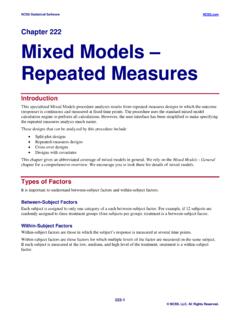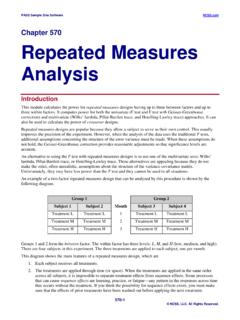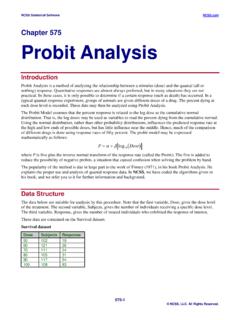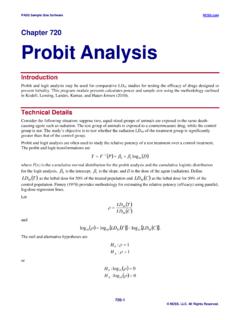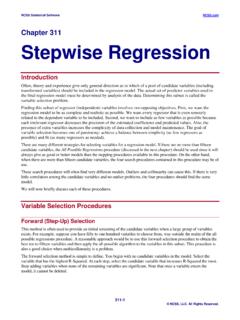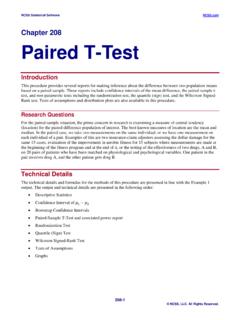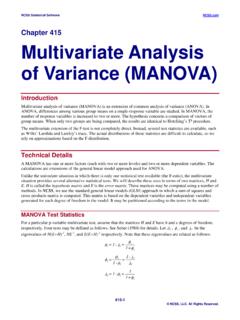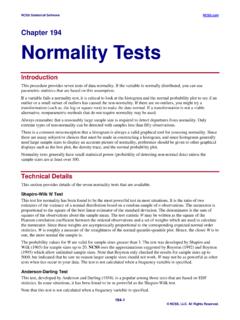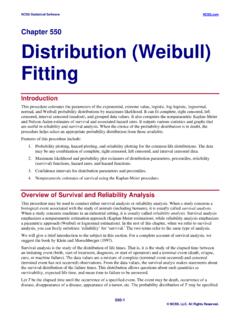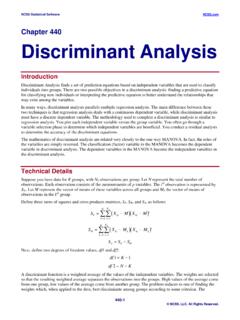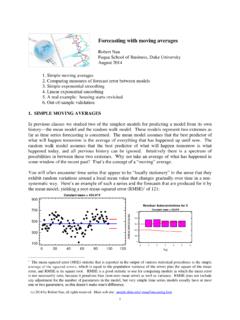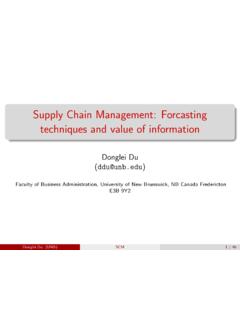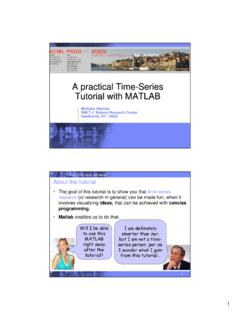Transcription of Chapter 469 Decomposition Forecasting
1 NCSS Statistical Software 469-1 NCSS, LLC. All Rights Reserved. Chapter 469 Decomposition Forecasting Introduction Classical time series Decomposition separates a time series into five components: mean, long-range trend, seasonality, cycle, and randomness. The Decomposition model is Value = (Mean) x (Trend) x (Seasonality) x (Cycle) x (Random). Note that this model is multiplicative rather than additive. Although additive models are more popular in other areas of statistics, forecasters have found that the multiplicative model fits a wider range of Forecasting situations.
2 Decomposition is popular among forecasters because it is easy to understand (and explain to others). While complex ARIMA models are often popular among statisticians, they are not as well accepted among Forecasting practitioners. For seasonal (monthly, weekly, or quarterly) data, Decomposition methods are often as accurate as the ARIMA methods and they provide additional information about the trend and cycle which may not be available in ARIMA methods. Decomposition has one disadvantage: the cycle component must be input by the forecaster since it is not estimated by the algorithm.
3 You can get around this by ignoring the cycle, or by assuming a constant value. Some forecasters consider this a strength because it allows the forecaster to enter information about the current business cycle into the forecast. Decomposition Method The basic Decomposition method consists of estimating the five components of the model XUTC S Rttttt= where Xt denotes the series or, optionally, log of series. U denotes the mean of the series. Tt denotes the linear trend. Ct denotes cycle. St denotes season.
4 Rt denotes random error. t denotes the time period. We will now take you through the steps used by the program to perform a Decomposition of a time series. Most of this information is from Makridakis (1978), Chapter 15. NCSS Statistical Software Decomposition Forecasting 469-2 NCSS, LLC. All Rights Reserved. Step 1 Remove the Mean The first step is to remove the mean by dividing each individual value by the series mean. This creates a new series that has values near one. This step is represented symbolically as YXUtt=/ If the absolute value of the mean of the series is less than , no division takes place.
5 Step 2 Calculate a moving Average The next step calculates an L-step moving average centered at the time period, t, where L is the length of the seasonality ( , L would be 12 for a monthly series or 4 for quarterly series). Since the moving average gives the mean of a year s data, the seasonality factor is removed. Usually, the averaging removes the randomness component as well. Symbolically, this step is represented as MYtt= where for odd L, the summation runs from t-[L/2] to t+[L/2]. The symbols [x] mean take the integer part of x.
6 Hence [ ]=6 and [11/2]=5. Notice that this summation range centers the moving average at t. For even L, the values usually found in practice (2, 4 and 12), it is a little more difficult to center the moving average on the time period t. For example, the average of the first 12 terms of a series would be centered at rather than 6. To center the average right on 7, we must compute the moving average centered at and at and then average these. The resulting double moving average is centered at the desired value of 7.
7 Another complexity that must be dealt with is what to do at the ends of the series. Because the average is centered, the first and last L/2 averages cannot be computed (because of the lack of data). Many different end-effect techniques have been proposed. Our end-effect strategy can best be explained by considering an example. Suppose we have a monthly series that runs from January of 1980 to December of 1988. To compute the moving average centered at January, 1980, we will need estimated data back through July, 1979.
8 The estimate of July 1979 is obtained by subtracting the difference of July, 1980 and July, 1981 from July, 1980. At the other end of the series we will need estimated values through June, 1989. To compute the estimated value for June, 1989, we add the difference of June, 1987 and June, 1988 to June, 1988. This method of estimating end-effects preserves local trends in the series. However, it is especially sensitive to outliers. You should remember that strange patterns in the last L/2 time periods may be from the end-effect calculation and not from a pattern in the series itself.
9 Step 3 Calculate the Trend The next step is to calculate and remove the trend component of the series. This calculation is made on the moving averages, Mt, rather than on the Yt series. A least squares fit is made of the of the model Mabtett= + + where a is the intercept. b is the slope. et is the residual or lack-of-linear-fit. NCSS Statistical Software Decomposition Forecasting 469-3 NCSS, LLC. All Rights Reserved. The linear portion of the above model is used to define the trend.
10 That is, we use Tabtt= + Note that because of the problems of end-effects, the first and last L/2 terms are omitted in the trend calculation. Step 4 Calculate the Cycle The cycle term is found by dividing the moving average by the computed trend. Symbolically, this is CMTttt= Step 5 Calculate the Seasonality The seasonality is computed by dividing the Y series by the moving averages. Symbolically, this is KYMttt= Note that the K series is composed of both the seasonality and the randomness.
